Agaricus subrufescens
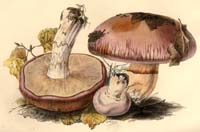 Key to Gilled Mushrooms Key
Key to Gilled Mushrooms KeyThis is a key to gilled mushrooms, that is, mushrooms having a definite cap with a fertile surface consisting of gills. The fruiting body usually also has a stem, although that may be lateral or absent (usually, then, the mushroom is growing from wood). You can use this key to identify mushrooms that you find.
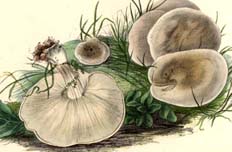 Agaricales Order
Agaricales OrderFruiting body containing fibers (usually in the stalk)
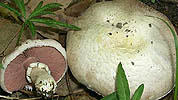 Agaricus Genus
Agaricus GenusGills free
Spore print chocolate brown
Annulus almost always present, usually membranous
The gills are usually pink or silvery-grey at first, but are colored chocolate brown at maturity from the developing spores
The cap and stalk are usually some sort of white or greyish brown, but may have fibrils or scales that are darker (like the portobello)
Growing on the ground, wood chips, or other organic debris
Arvenses SectionCap up to 7" across
Flesh stains or ages yellow, and stays yellow (on its own, or with KOH)
Partial veil usually has two distinct layers.
Mature fruiting body usually quite tall (stem 5-10" long), and often quite wide as well
Odor sweet, usually almondy, sometimes of anise, but different people will sometimes perceive it differently
The gills are greyish at first, not pink
Robust Arvenses SubSectionStem robust in proportion to the cap
Cap glabrous or fibrillose, but not silky (although the cap is sometimes shiny)
Scent sometimes quite strong
Usually in grass or wood chips
Agaricus subrufescens Peck
Here are the characters that distinguish this species from the others in its group. For its more general characters, see higher up on the page.
If there's just a few words or a microscopic feature here, a more thorough description can be found above.
Diagnosis
- Some of our Chicago collections had a very silvery cap with just a few scattered, blackish fibrils. Those probably shouldn't have ended up here, or rather, the species concepts for this genus probably shouldn't be so vaguely drawn as to assign such collections to this name
Microscropic Characters
Comments
This is a somewhat controversial mushroom in this area; macroscopically, it looks like everyone's concept of Agaricus augustus. Two quotations to contextualize the situation:
David Arora (in his discussion of A. subrufescens in Mushrooms Demystified): "In eastern North America, an edible Agaricus with tawny scales on the cap ( like A. augustus), a shaggy stalk, and weaker almond odor has also gone under the name A. subrufescens, apparently because of its similarly-sized spores. Whether it is a distinct species or merely an extreme form of A. subrufescens is for licensed Agaricus-experts to decide."
Patrick Leacock (in identifying collections brought in to the Field Museum as A. subrufescens, when everyone else wanted to call it A. augustus): "Yeah, we found this a few times in Minnesota, and everyone wanted to call it A. augustus there, also; but it always turned out to be subrufescens."
At first, I was thinking of including "our" subrufescens here under a provisional name (just for the fun of it), but I eventually came to the following conclusions:
1) Agaricus subrufescens was originally described by Peck. So, if there is a difference between the California version of Agaricus subrufescens and our local one, ours is the real one, and it is the California version that needs the new name
2) Agaricus has never been monographed in Eastern North America (well, okay, except by Peck for New York State), but Rick Kerrigan has done a lot of the work on the genus in California. In California, culturally, "the" big yellowish fibrillose Agaricus is augustus (as in the big photo on the cover of Mushrooms Demystified); subrufescens is a much less common and less "important" mushroom there, with a cap that is less yellow and more non-descript in general. With California dominating the published descriptions of this genus, our eyes have been adjusted for California species
3) So I'm going to follow the lead of A. E. Bessette, D. W. Fischer & A. R. Bessette (1997) here in re-picturing (in effect, re-describing) the original, Eastern version of Agaricus subrufescens
Our own photos will be up as soon as I get a decent film scanner. In the meantime, it is well-illustrated by the picture of A. subrufescens in A. E. Bessette, D. W. Fischer & A. R. Bessette (1997) , and by the pictures of A. augustus in Lincoff (1987) and Arora (1986) (see discussion below)

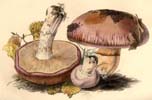


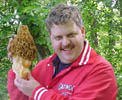

 Key to Gilled Mushrooms Key
Key to Gilled Mushrooms Key Agaricales Order
Agaricales Order Agaricus Genus
Agaricus Genus




